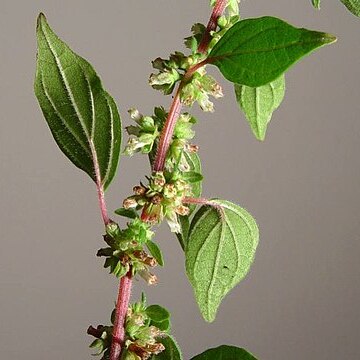Herbs, annual or perennial, without stinging hairs. Leaves alternate; stipules absent; leaf blade 3-veined or triplinerved, margin entire; cystoliths punctiform. Inflorescences axillary, clusters or cymes of unisexual or bisexual flowers (plants monoecious); bracts calyxlike. Bisexual flowers: perianth lobes 3 or 4, linear, valvate. Male flowers: perianth lobes 3 or 4; rudimentary ovary minute. Female flowers: perianth lobes 3 or 4, connate to a tube at base, much shorter than male lobes. staminodes absent. Ovary straight, free from perianth; style short or absent; stigma penicillate or spatulate; deciduous, ovule orthotropous. Achene ovoid, slightly compressed, with lustrous and crustaceous pericarp, enclosed by dry persistent perianth. Seeds with endosperm; cotyledons oblong-ovate.
Monoecious or polygamous annual or perennial herbs, usually densely pubescent with hooked or curved hairs. Leaves alternate, chartaceous, entire, 3-veined, petiolate; stipules absent. Flowers in clusters or cymules in axils, the lateral flowers with an involucre of leafy bracts. Male flowers: tepals 3 or 4; stamens 3 or 4. Female flowers: perianth 3-or 4-dentate enclosing the free ovary; stigma subcapitate to capitate, dense with long stigmatic processes. Bisexual flowers: perianth and stamens as in males, pistil as in females. Achenes ovoid, smooth to polished, brown, enclosed by persistent perianth subtended by foliaceous bracts.
Annual or perennial herbs, polygamous. Leaves alternate, petiolate, entire, cystoliths dot-like; stipules absent. Inflorescences of paired sessile or shortly pedunculate clusters in leaf-axils; bracts sometimes very prominent. Flowers bisexual or unisexual. Hermaphrodite flowers: 3-or 4-merous; tepals almost free.. Male flowers: 3-or 4-merous; tepals almost free; rudimentary ovary present.. Female flowers: with ± tubular, 3-or 4-lobed perianth, stigma sessile, penicillate, decidous, ovary symmetrical. Achene enclosed in persistent perianth.
Fls in congested cymes, perfect and protogynous to unisexual; ♂ and perfect fls with deeply 3-4-partite per., segs valvate, stamens 3-4, inflexed in bud. ♀ with tubular per., 3-4-lobed; ovary free, ovule solitary, erect; stigma penicillate. Achene invested by enlarged per. Annual or perennial herbs with alt., petiolate, entire lvs; stipules minute. Genus of some 10 spp. of temperate and tropical regions. The N.Z. sp. is apparently widespread elsewhere, but critical comparisons are necessary.
Annual or perennial herbs, sometimes woody at base, without stinging hairs. Lvs alternate, entire, exstipulate. Cymes axillary. Fls inconspicuous, ☿ or unisexual, bracteolate. Perianth green or variously tinged; perianth of ♀ fls 4-partite; perianth of ☿ fls 4-partite, connate at base at flowering, becoming tubular and 4-toothed at fruiting; ☿ fls strongly protogynous. Achenes enclosed in perianth and sometimes in bracteoles.
Monoecious or polygamous; staminate fls with deeply 4-parted cal and 4 stamens; cal of the pistillate fls tubular at base, 4-lobed; ovary compressed, ovoid; stigma subsessile; fr an achene, loosely enclosed by the accrescent cal; herbs with alternate, entire, exstipulate lvs and short, axillary clusters of few fls subtended and exceeded by green bracts. 30, widespread.

